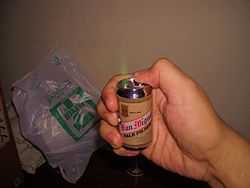Novelty lighter

A novelty lighter is a lighter that is shaped like another object. Novelty Lighters can have audio or visual effects, and may look like toys. They are typically used to light tobacco products.
Controversy surrounding novelty lighters
In the United States. the vast majority of fires caused by children are started with non-novelty lighters and matches (matches are the leading cause of fires started by children).[1] According to the National Association of Fire Marshals, despite attempts to collect statistical evidence concerning the prevalence of novelty lighter fires caused by children, only anecdotal evidence of such fires could be found.[2] Thus, of the 3,168 fires caused by children playing with matches and lighters in 2004 in the United States, no cases were attributed to novelty lighters by the National Association of Fire Marshals.[3] In one such anecdotal case, on September 25, 2007, two toddlers from Russellville, Arkansas, died after setting fire to their apartment with a motorcycle-shaped lighter that was imported illegally.[4] Such tragic cases are often caused by lighters that lack proper child safety mechanisms as mandated by the Consumer Product Safety Commission. In the United States lighters must be child safe (children under 51 months must be unable to light the lighter with 100 children being used in testing). However, lighters manufactured at a cost higher than $2.50 do not have to be child safe. The Lighter Association, a lobbying organization pushing for the U.S. Congress to ban novelty lighters, draws its board members from Bic, Scripto, Swedish Match, and Calico Brands (four of the largest non-novelty lighter manufacturers).[5] This constitutes a significant conflict of interest as non-novelty lighter manufacturers have a significant financial incentive to decrease competition from novelty lighter manufacturers despite the lack of statistical evidence that novelty lighters are more dangerous to children than non-novelty lighters.
Bans on novelty lighters
On May 11, 2006, the European Consumer Protection Commission adopted a decision requiring Member States to ensure that, from March 11, 2007, cigarette lighters are child-resistant when placed on the EU market. The decision also prohibits placing lighters on the market that resemble objects that are particularly attractive to children.[6]
In the United States, Maine was the first state to ban the sale of novelty lighters. This ban came about after the son of a Maine fire chief singed his eyebrow on a novelty lighter shaped like a baseball bat.[7] Since then, Tennessee, Oregon, and Arkansas have also banned novelty lighters. The Virginia Legislature recently passed legislation to ban novelty lighters, and is waiting for Virginia Governor Tim Kaine to sign the bill.[8]
Many cities and counties in the United States have passed ordinances banning novelty lighters. They include:
- California: Cathedral City, Chula Vista, El Cajon, Encinitas, Highland, La Mesa, National City, Redlands, San Diego City, Solana Beach, Vista
- Georgia: Dawson County, Dawsonville
- Kentucky: Shively
- Maryland: City of Laurel
- Mississippi: Meridian
- Ohio: Huber Heights, Dayton
- Washington: City of Yakima, Sunnyside, Yakima County
- Wyoming: Burns[9]
- Hawaii
- New York
U.S. Senators Chris Dodd (D-Conn.), Ron Wyden (D-Ore.), and Susan Collins (R-Maine) introduced the “Protect Children from Dangerous Lighters Act” in 2008, which would ban these lighters nationally.
Novelty lighters were banned from sale and manufacture in South Australia on 6 January 2010.
References
- ↑ http://nfa.usfa.dhs.gov/downloads/pdf/statistics/v4i1.pdf
- ↑ http://www.firemarshalsarchives.org/pdf/background_for_Novelty_Lighters.pdf
- ↑ http://www.firemarshalsarchives.org/pdf/background_for_Novelty_Lighters.pdf
- ↑ "Arson Awareness Week Media Kit" (PDF). Retrieved 2010-10-07.
- ↑ http://www.lighterassociation.org/membership_2014.pdf
- ↑ "EUROPA - Press Releases - EU bans sale of non-child resistant and novelty cigarette lighters". Europa.eu. Retrieved 2010-10-07.
- ↑ "Maine first state to ban novelty lighters - Health - Kids and parenting - msnbc.com". MSNBC. 2008-03-24. Retrieved 2010-10-07.
- ↑
- ↑ "Oregon State Police - Oregon Office of State Fire Marshal Novelty (Toylike) Lighters". Oregon.gov. 2010-09-02. Retrieved 2010-10-07.